Customer churn prediction with Google AutoML
In today’s highly competitive business landscape, customer retention is essential for the long-term success of any company. One major challenge organisations face is customer churn prediction. It refers to the rate at which customers stop doing business with a company. the rate at which customers discontinue doing business with a company is a major challenge that businesses face. Google’s AutoML offers a suite of tools that allow developers to build and deploy machine learning models with minimal effort. In turn, it helps you identify patterns and factors that contribute to customer churn.
By using AutoML, you can utilise machine learning for customer churn prediction and create accurate models that forecast customer attrition. This enables you to take proactive measures to enhance customer experience and retention.
In this article, written by Dawid Marczak (AI Data Scientist), and based on a solution developed by Piotr Zakrzewski (Senior AI Data Scientist), we will explore how Google AutoML can help you predict customer churn and effectively implement retention strategies.
Data preparation and exploration – the first step of customer churn prediction
The first step is to examine the available data to gain insights about the customers. Google Cloud Platform offers a great tool for data analytics and data trends visualisation called Looker. The dataset used for this analysis includes approximately 7,000 users based in the UK, with 1,869 of them classified as “churn”.
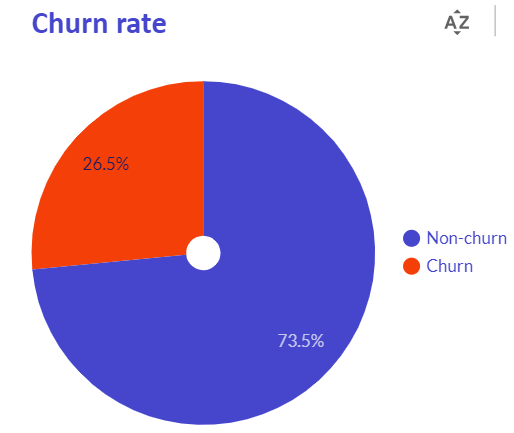
Understanding the dataset
The dataset contains features such as Tenure, Contract type, Total charges, Monthly charges, Payment method, Gender, and various indicators of the telecom services being used, such as TV, Internet, and Streaming Movies.
In the sample dataset we’re analysing, one of the most significant driving factors for customer retention is tenure, which refers to how long a customer has been using the company’s services. This raises an interesting “which comes first?” debate regarding retention and tenure. However, it’s not surprising that customers who have been loyal to a company for many years continue to be so. This trend is evident in the IBM telecom data when comparing “churn” and “non-churn” users across different tenure values.
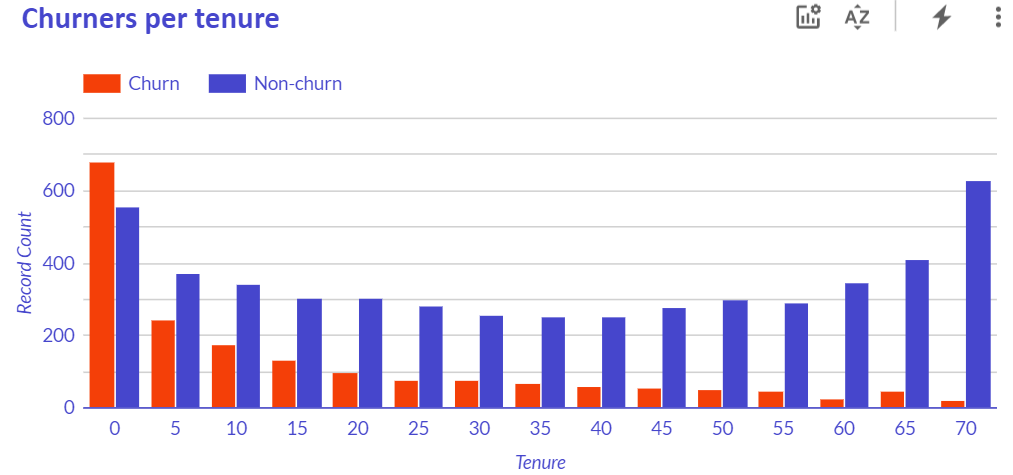
Contract types and their impact on churn
Upon further examination of the data points, we find that the company offers three types of contract periods:
- Month-to-month
- One year
- Two years
This categorisation could significantly influence customer churn as we analyse the average monthly charges in relation to the average tenure for each group. Month-to-month users pay the most out of the three contract types and tend to remain with the company for the shortest period. It averages less than 20 months. In contrast, the users with two-year contracts stay the longest, averaging about 24 months. They also enjoy the lowest monthly charges, just under $61.
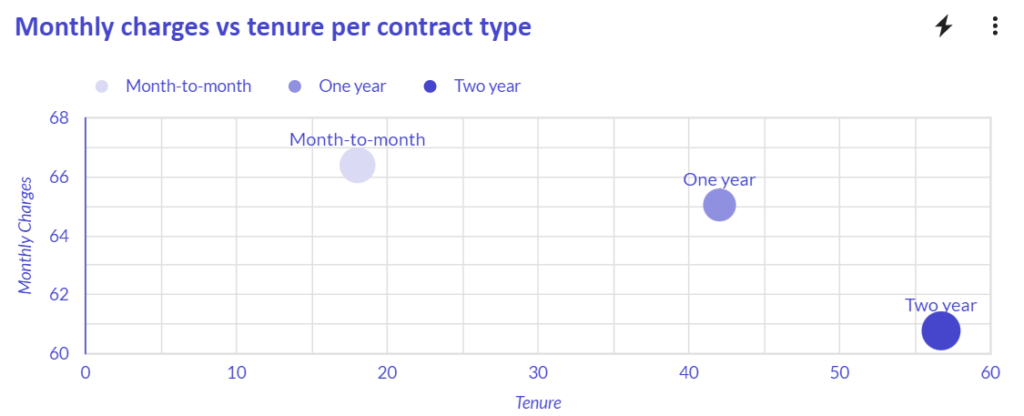
Revenue insights based on contract types
A simple business insight to draw is the average revenue generated by a user of each group:
| Contract type | Average revenue per user (tenure x charges) |
| Month-to-month | $1,188 (18 x $66) |
| One year | $2,730 (42 x $65) |
| Two year | $3,416 (56 x $61) |
Firstly, it’s important to note that a “One-year” user generates $1,500 more revenue than a “Month-to-month” user. On average, monthly users tend to stay with the company for 18 months, which is more than a year. Therefore, upgrading their contract to a yearly subscription would benefit them with lower monthly charges and provide the company with increased revenue over a longer period.
A similar situation arises when converting a “One-year” user to “Two-year” subscription. On average, a “One-year” user generates $2,730 in revenue and remains with the company for 42 months. If these users were converted to a “Two-year” subscription, it could result in an additional revenue increase of $700 per user.
No matter the type of contract, the main idea is clear: the longer a user stays with the company, the more revenue it generates. To retain customers effectively, it’s essential to identify which users are at risk of churning and to create incentives that encourage them to continue using the company’s services.
Machine Learning model for predicting customer churn
AutoML, or Automated Machine Learning, is revolutionising the way businesses tackle machine learning and predict customer churn. It automates various time-consuming tasks, such as feature engineering, hyperparameter tuning, and model selection, which are necessary for a traditional machine learning approach. This enables rapid experimentation with high-quality models tailored to specific business needs.
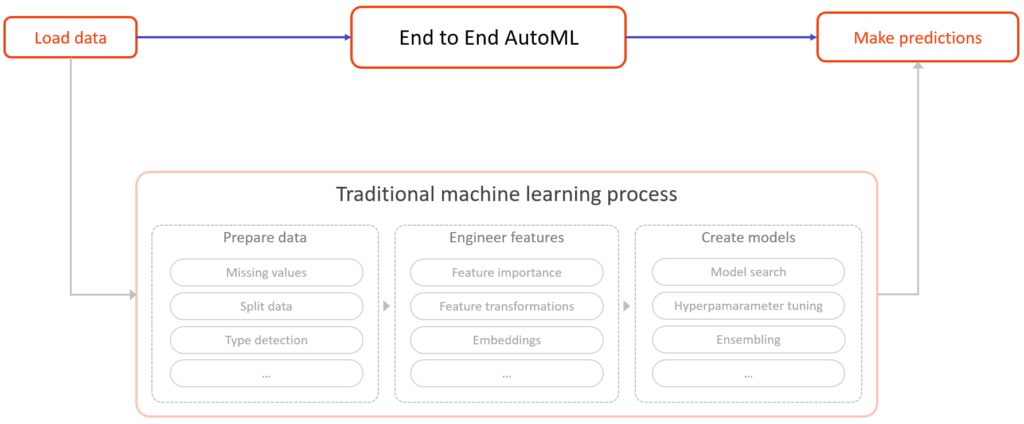
Source: YouTube
Training your churn prediction model with Vertex AI
Google Cloud offers a powerful tool which can easily carry out AutoML tasks – Vertex AI. Once you have loaded the data into Google Cloud, follow these steps to train a new model.
Step-by-step instructions
1. Log in to Google Cloud Platform and navigate to Vertex AI > Training. If this is your first time using it, you may need to find it under “MORE PRODUCTS”.
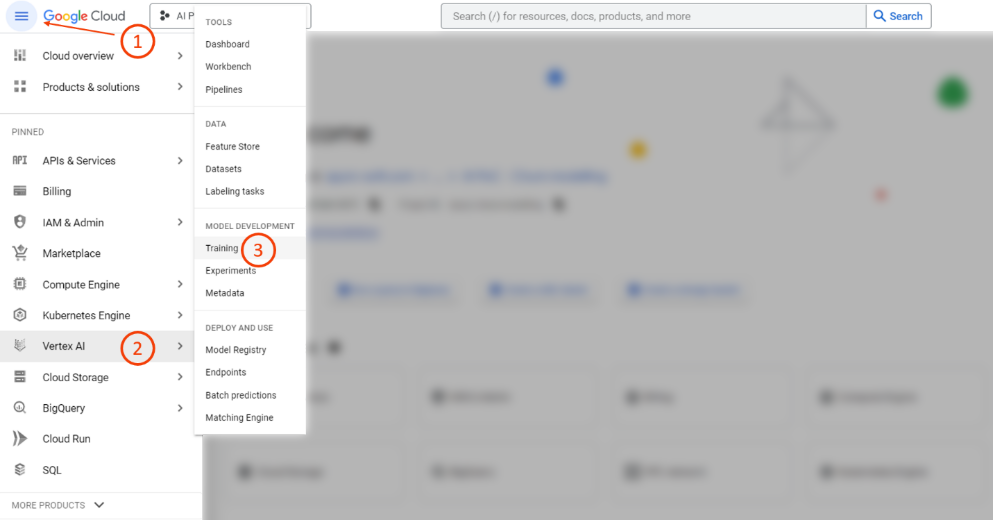
2. Create a new model and begin the training process.

3. Select your dataset, which in this case is “auto-ml-churn-test”. Choose the objective as “Classification” and then select “AutoML.”
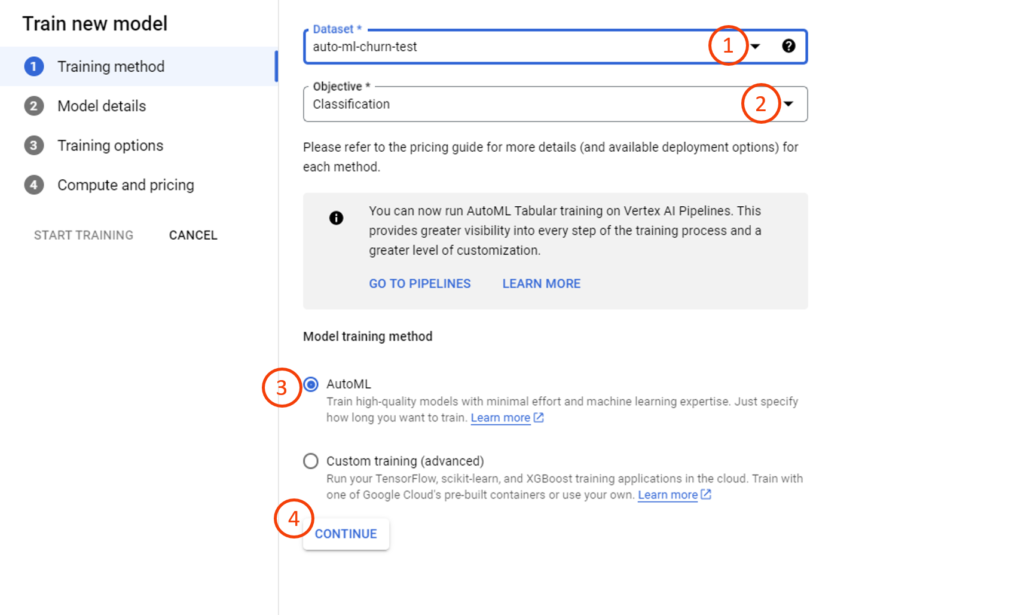
4. Fill in all the required details and ensure you select the correct target column, such as “Churn.” There’s no need to go into the “Advanced Options”.

5. Confirm whether you want to use all the available columns and verify that the target column is correct.
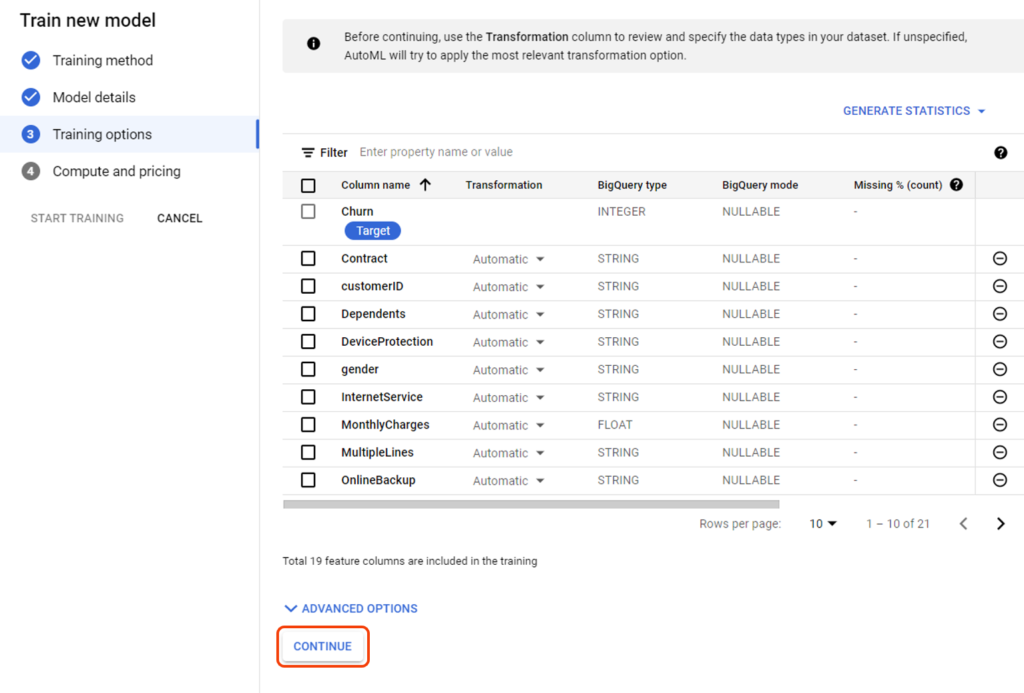
6. Now it’s time for the best part. You can specify the number of hours you wish to allocate for training. In this case, we opted for only 2 hours, as the churn dataset is small. Additionally, you have the option to “Enable early stopping”, which will terminate the model training if it stops making progress.
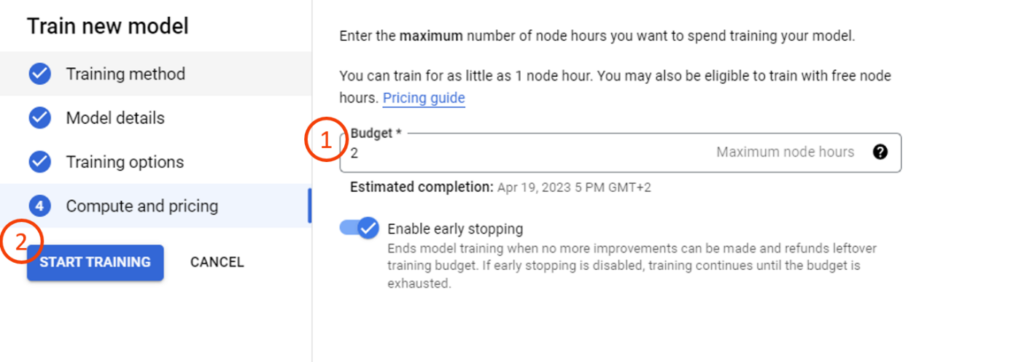
7. Once the designated training time is complete, your model will be ready. The results will be accessible in the Model Registry within Vertex AI.
Results & insights
In our Telecom churn dataset analysis, we achieved an ROC AUC score of 0.889, which indicates that the model is of very high quality. Furthermore, at a confidence threshold of 0.7, the model attained a Precision score of 88.6%. This means that 9 out of 10 predictions made by the model for the “Churn” label in the test set were correct.
Key drivers of churn rate
At Spyrosoft, we focus on the practical application of AI in business to maximise value for our clients. Combining the power of the model feature importance in Vertex AI and the visual capabilities of Looker dashboards, we identified Tenure and Contract features as the two most significant drivers of churn in the data.
The bar chart on the left side illustrates the importance of each feature in the data, indicating their impact on user retention. The line chart below shows that lower tenure is associated with a higher likelihood of churn. We observed the highest churn rates at a tenure of zero months, and the lowest rates occurred between 60 and 70 months.
The bar chart showing feature importance for contracts suggests that users on two-year contracts are significantly more likely to remain with the company compared to those on month-to-month contracts. This further reinforces the insights we gained during our initial analysis of the data.

Retention & churn analysis at the individual level
The next step in analysing and predicting customer churn is to focus on specific individuals who are likely to leave. By examining factors such as a customer’s churn score, service call log, monthly payment, and data usage, we can gain a clearer understanding of their current situation and identify potential pain points. To illustrate this, we provide a comparison of two customer profiles below: Evie Goddard and Max Knight (fictional names).

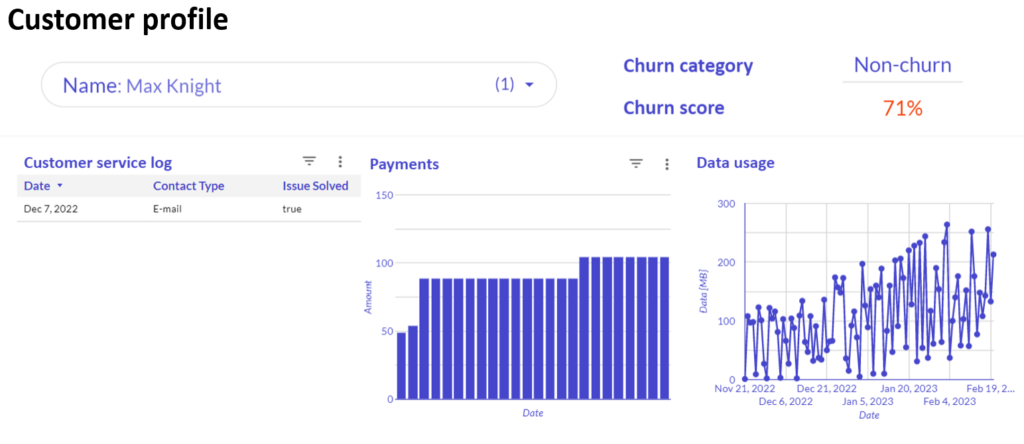
Example 1: Evie Goddard – already churned
Evie Goddard is an example of a customer who has already churned. Many of her issues went unresolved, and her monthly payments increased dramatically. This ultimately resulted in her dropping the company’s services. Although there is little that can be done in Evie’s case, her situation provides valuable insights for the company’s future churn prediction efforts.
Example 2: Max Knight – likely to churn
On the other hand, Max Knight is a customer who continues to use the company services, but his churn score is notably high. This indicates that offering Max some incentives could make a significant difference in whether he chooses to stay with the company or decides to leave.
Acting on predictions
Finally, to enhance our focus on delivering value to our clients, we compiled a list of the top 25 customers with the highest churn scores. This list allows the telecom company to proactively reach out to the customers identified as high-risk. The company can offer them incentives or discounts to prevent churn and maintain their satisfaction. With more data on potential actions, we can create a tailored recommendations for each individual customer. However, in our demo, we didn’t have access to such data, so the recommendation provided was the same for everyone.
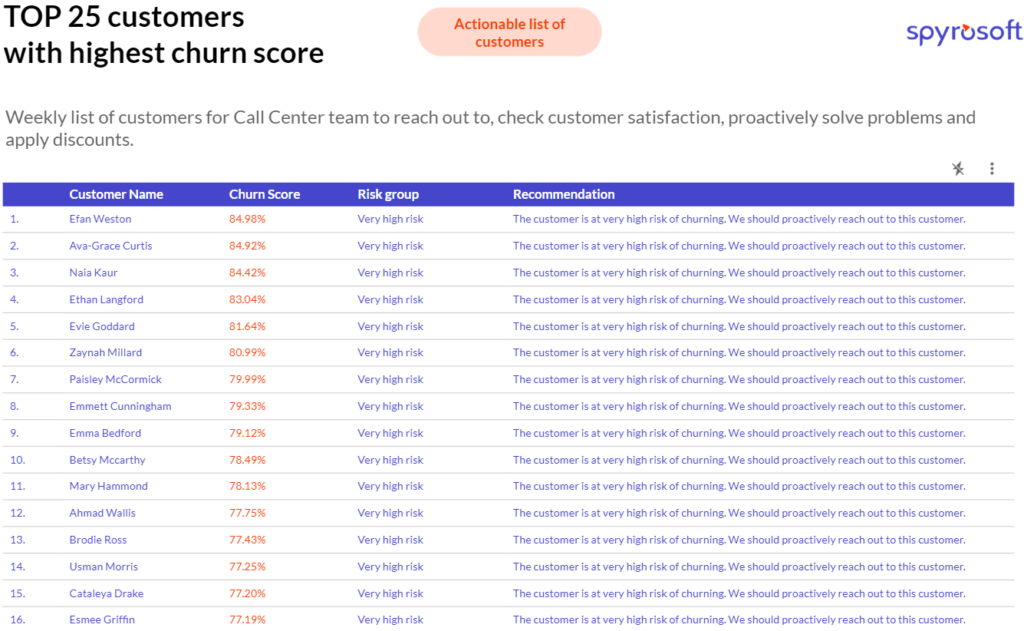
Conclusion: Benefit from customer churn prediction using machine learning model
Churn prediction of customers is a critical issue for businesses. With the help of Google Cloud Platform’s AutoML and Looker, companies can leverage machine learning algorithms to develop predictive models that accurately identify customers at risk of leaving. This technology allows businesses to take proactive steps to retain customers and increase customer lifetime value.
Google AutoML is an easy-to-use tool suitable for companies of all sizes. By adopting this technology, you can implement effective churn prediction. This can lead to improved customer retention, increased revenue, and a competitive advantage in their industry. Additionally, with support from Spyrosoft, businesses can take full advantage of Google’s machine learning solutions. It’s a good way to keep up in this fast-paced world of data-driven decision-making.
Leverage our AI expertise to transform your business
Learn moreHarness an Automated Machine Learning model to predict churn of customers
At Spyrosoft, we are set on leveraging AI solutions and applying them in practice to maximise the value offered to our clients. For instance, one compelling application is customer churn prediction, where machine learning models and the AutoML approach can have a significant impact. However, there are many other examples of its usefulness, such as propensity modeling, predictive maintenance, sales and demand forecasting, and many others.
Reach out to us if you’re interested in learning more about how AI and machine learning algorithms could help your business.
FAQ
A churn prediction model is a predictive model that uses customer data, such as usage patterns, transaction history, and support interactions, to forecast whether a customer is likely to stop using a service. It applies machine learning techniques like decision trees, support vector machines, or neural networks to learn from historical data and identify patterns associated with high churn risk.
The churn rate represents the percentage of customers who stop doing business with a company during a given period. Monitoring this metric helps organisations evaluate their customer retention strategies and take action to reduce churn, ultimately increasing the value of their customer base.
To build a robust churn model, you need a well-structured data that includes customer behavior, demographics, usage history, product/service interactions, and whether or not a customer has churned in the past. The more detailed the customer data, the more accurate your model will be.
Churn analysis helps teams understand why customers are leaving and what can be done to retain them. It supports customer success by providing insights that inform personalised interventions, improved onboarding, and better engagement strategies. This helps improve customer satisfaction and loyalty.
Yes. By helping companies reduce customer churn, churn prediction models indirectly lower the pressure on customer acquisition. Keeping existing customers is often more cost-effective than acquiring new customers, making retention efforts key to long-term profitability.
About the author
Contact us





